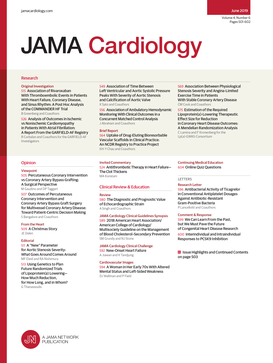Treatment Strategies to Control Blood Pressure in People With Hypertension in Tanzania and Lesotho
IF 14.8
1区 医学
Q1 CARDIAC & CARDIOVASCULAR SYSTEMS
引用次数: 0
Abstract
ImportanceHypertension is the primary cardiovascular risk factor in Africa. Recently revised World Health Organization guidelines recommend starting antihypertensive dual therapy; clinical efficacy and tolerability of low-dose triple combination remain unclear.ObjectivesTo compare the effect of 3 treatment strategies on blood pressure control among persons with untreated hypertension in Africa.Design, Setting, and ParticipantsThis was an open-label, parallel, 3-arm randomized clinical trial to evaluate noninferiority of a strategy starting 2 pills vs full-dose monotherapy with stepped escalation (noninferiority margin 10%) and superiority of starting low-dose 3 pills vs monotherapy allowing for monthly up titration. Recruitment lasted from March 5, 2020, to March 30, 2022. The setting was 2 hospitals in rural Lesotho and Tanzania. Participants included nonpregnant Black African individuals 18 years and older with uncomplicated, untreated hypertension (standardized office blood pressure ≥140 mm Hg systolic or ≥90 mm Hg diastolic).InterventionsParticipants were randomized 2:2:1 to stepped monotherapy (amlodipine, 10 mg, with escalation to add hydrochlorothiazide if needed), 2-pill strategy (amlodipine, 5 mg; losartan, 25 mg), or 3-pill strategy (amlodipine, 2.5 mg; losartan, 12.5 mg; hydrochlorothiazide, 6.25 mg). Drugs were up titrated monthly until reaching the target blood pressure (≤ 130/80 mm Hg for participants aged <65 years; ≤140/90 mm Hg for those aged ≥65 years).Main Outcomes and MeasuresProportion of participants reaching target blood pressure at 12 weeks.ResultsOf 1761 participants screened, 1268 were enrolled (median [IQR] age, 54 [45-65] years; 914 female [72%]), with 505 in the monotherapy cohort, 510 in the 2-pill cohort, and 253 in the 3-pill cohort. In noninferiority analyses, 207 of 370 participants (56%) receiving the 2-pill strategy and 173 of 338 participants (51%) receiving the stepped monotherapy strategy achieved the blood pressure target (adjusted odds ratio [aOR], 1.18; 95% CI, 0.87-1.61), fulfilling noninferiority. In superiority analyses after multiple imputation for missing outcome data, 57% of participants receiving the 3-pill strategy, 55% receiving the 2-pill strategy, and 49% receiving the stepped monotherapy strategy reached the target blood pressure (aOR, 1.24; 95% CI, 0.94-1.63;坦桑尼亚和莱索托高血压患者控制血压的治疗策略
在非洲,高血压是主要的心血管危险因素。最近修订的世界卫生组织指南建议开始抗高血压双重治疗;低剂量三联用药的临床疗效和耐受性尚不清楚。目的比较3种治疗策略对非洲高血压患者血压控制的影响。设计、环境和参与者:这是一项开放标签、平行、三组随机临床试验,旨在评估一种策略的非劣效性,即开始服用2粒药片与逐步递增的全剂量单药治疗(非劣效性边际为10%),以及开始服用低剂量3粒药片与单药治疗的优越性,允许每月上升滴定。招聘时间为2020年3月5日至2022年3月30日。实验地点是莱索托和坦桑尼亚农村地区的两家医院。参与者包括18岁及以上无并发症、未经治疗的高血压(标准化办公室血压≥140 mm Hg收缩压或≥90 mm Hg舒张压)的非怀孕黑人个体。干预措施:受试者按2:2:1随机分为单药治疗(氨氯地平,10mg,如有需要可逐步加入氢氯噻嗪)、2片治疗(氨氯地平,5mg;氯沙坦,25毫克),或3片策略(氨氯地平,2.5毫克;氯沙坦,12.5 mg;氢氯噻嗪,6.25毫克)。药物每月递增滴定,直到达到目标血压(≤130/80 mm Hg,年龄为65岁;≥65岁≤140/90 mm Hg)。受试者在12周达到目标血压的比例。结果在筛选的1761名参与者中,1268人入组(中位[IQR]年龄54[45-65]岁;914名女性[72%]),其中单药组505名,2粒组510名,3粒组253名。在非劣效性分析中,370名受试者中有207名(56%)接受2粒药物治疗,338名受试者中有173名(51%)接受分步单药治疗,达到了血压目标(调整优势比[aOR], 1.18;95% CI, 0.87-1.61),满足非劣效性。在对缺失结局数据进行多次代入后的优势分析中,57%接受3片策略的参与者、55%接受2片策略的参与者和49%接受分步单药治疗策略的参与者达到了目标血压(aOR, 1.24;95% ci, 0.94-1.63;P = 0.12, aOR为1.28;95% ci, 0.91-1.79;2片和3片与分步单药治疗策略的P = 0.16)。结论和相关性这项随机临床试验的结果显示,在2个非洲环境中,对于无并发症的未治疗高血压的成年人,开始2粒低剂量治疗的策略并不亚于开始分步单药治疗。两丸和三丸低剂量策略并不优于分步单药治疗。广泛的ci排除了额外药丸策略对高血压控制的潜在临床重要作用。临床试验注册号:NCT04129840
本文章由计算机程序翻译,如有差异,请以英文原文为准。
求助全文
约1分钟内获得全文
求助全文
来源期刊

JAMA cardiology
Medicine-Cardiology and Cardiovascular Medicine
CiteScore
45.80
自引率
1.70%
发文量
264
期刊介绍:
JAMA Cardiology, an international peer-reviewed journal, serves as the premier publication for clinical investigators, clinicians, and trainees in cardiovascular medicine worldwide. As a member of the JAMA Network, it aligns with a consortium of peer-reviewed general medical and specialty publications.
Published online weekly, every Wednesday, and in 12 print/online issues annually, JAMA Cardiology attracts over 4.3 million annual article views and downloads. Research articles become freely accessible online 12 months post-publication without any author fees. Moreover, the online version is readily accessible to institutions in developing countries through the World Health Organization's HINARI program.
Positioned at the intersection of clinical investigation, actionable clinical science, and clinical practice, JAMA Cardiology prioritizes traditional and evolving cardiovascular medicine, alongside evidence-based health policy. It places particular emphasis on health equity, especially when grounded in original science, as a top editorial priority.
 求助内容:
求助内容: 应助结果提醒方式:
应助结果提醒方式:


